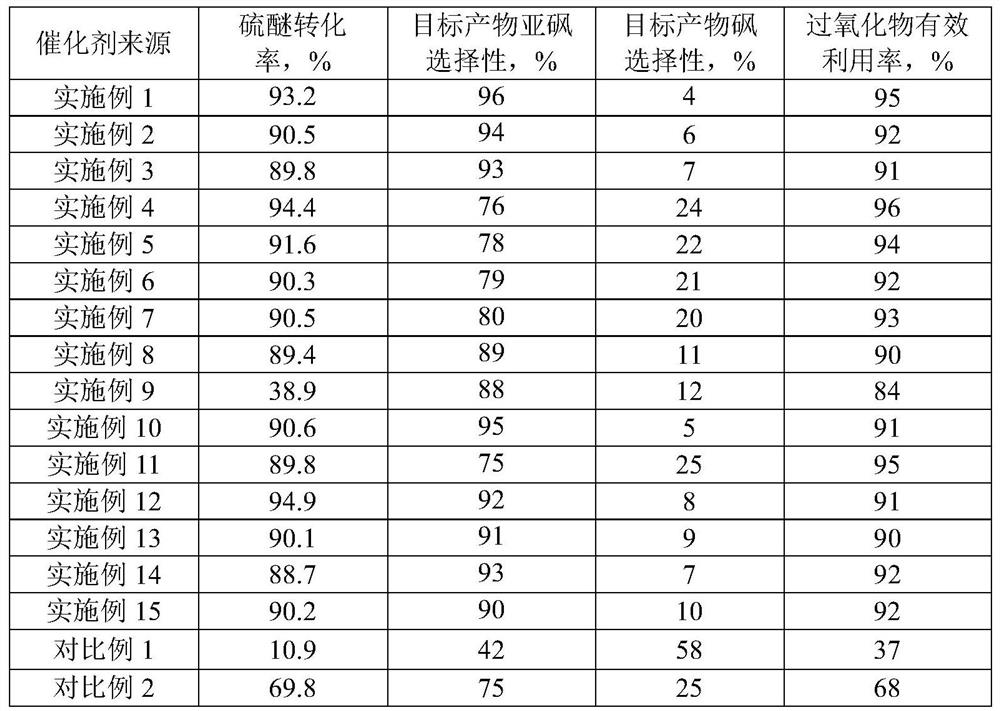Method of oxidizing thioether
A technology for oxidizing sulfide and sulfide, applied in chemical instruments and methods, preparation of organic compounds, organic chemistry, etc., can solve the problems of limiting the application scope of peroxide oxidation method, high price of oxidants, and large dosage.
- Summary
- Abstract
- Description
- Claims
- Application Information
AI Technical Summary
Problems solved by technology
Method used
Image
Examples
preparation Embodiment 1
[0055] Add 500mL to the beaker and the resistivity is 15MΩ·cm -1 The ultrapure water, anode graphite rod (diameter 10mm length 30cm) and cathode graphite rod (diameter 10mm length 30cm) are placed in it, keep the distance between the anode graphite rod and cathode graphite rod at 10cm, anode graphite rod and direct current Connect the positive pole of the power supply and connect the cathode graphite rod to the negative pole of the direct current power supply, apply a voltage of 50V to carry out electrolysis for 8 days, and obtain the electrolyte solution after electrolysis. Mix the electrolyzed electrolyte solution with 30% by weight hydrogen peroxide at a weight ratio of 1:5, then conduct modification treatment at 80°C for 12 hours, and then freeze the modified material at -20°C, 50Pa After drying for 24 hours, the modified nano-carbon-based material C1 was obtained, the particle size of which was 8nm.
preparation Embodiment 2
[0057] Add 1500mL to the beaker and the resistivity is 15MΩ·cm -1 The ultrapure water, anode graphite rod (diameter 20mm length 30cm) and cathode graphite rod (diameter 20mm length 30cm) are placed in it, keep the distance between the anode graphite rod and cathode graphite rod at 5cm, anode graphite rod and DC Connect the positive pole of the power supply and connect the cathode graphite rod to the negative pole of the direct current power supply, apply a voltage of 100V to carry out electrolysis for 18 days, and obtain the electrolyte after electrolysis. Mix the electrolyzed electrolyte solution with 30% by weight hydrogen peroxide at a weight ratio of 1:80, and then perform modification treatment at 100°C for 18 hours, and then freeze the modified material at -20°C, 50Pa After drying for 24 hours, the modified nano-carbon-based material C2 was obtained, and its particle size was 23 nm.
preparation Embodiment 3
[0059] Add 500mL to the beaker and the resistivity is 15MΩ·cm -1 The ultrapure water, anode graphite rod (diameter 10mm length 30cm) and cathode graphite rod (diameter 10mm length 30cm) are placed in it, keep the distance between the anode graphite rod and cathode graphite rod at 10cm, anode graphite rod and direct current Connect the positive pole of the power supply and connect the cathode graphite rod to the negative pole of the direct current power supply, apply a voltage of 50V to carry out electrolysis for 12 days, and obtain the electrolyte solution after electrolysis. Mix the electrolyzed electrolyte solution with 30% by weight hydrogen peroxide at a weight ratio of 1:120, then conduct modification treatment at 120°C for 24 hours, and then freeze the modified material at -20°C, 50Pa After drying for 24 hours, the modified nano-carbon-based material C3 was obtained, the particle size of which was 5 nm.
PUM
| Property | Measurement | Unit |
|---|---|---|
| diameter | aaaaa | aaaaa |
| length | aaaaa | aaaaa |
| electrical resistivity | aaaaa | aaaaa |
Abstract
Description
Claims
Application Information
 Login to View More
Login to View More - R&D
- Intellectual Property
- Life Sciences
- Materials
- Tech Scout
- Unparalleled Data Quality
- Higher Quality Content
- 60% Fewer Hallucinations
Browse by: Latest US Patents, China's latest patents, Technical Efficacy Thesaurus, Application Domain, Technology Topic, Popular Technical Reports.
© 2025 PatSnap. All rights reserved.Legal|Privacy policy|Modern Slavery Act Transparency Statement|Sitemap|About US| Contact US: help@patsnap.com

